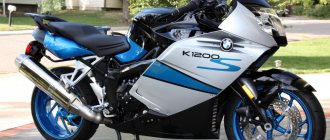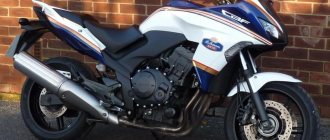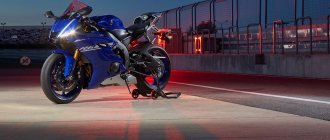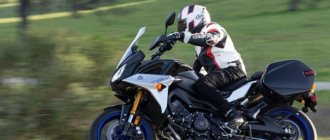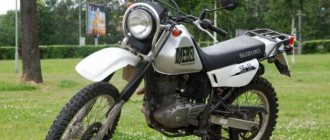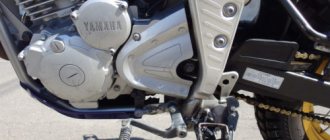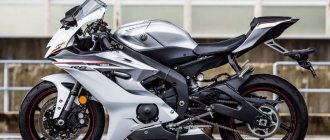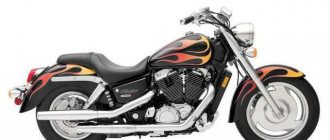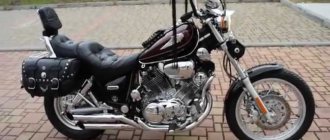This is a classic sports motorcycle, which at one time was even named the best model of the decade. Then, in the late eighties, the characteristics of the Yamaha FZR 1000 were really impressive, because even now this machine can surpass many of its classmates. What is worth at least is the fact that the bike is capable of reaching speeds of up to 270 km/h, and in other cases – even higher.
Excellent wind protection, ideal handling at high speeds, good performance at low speeds relative to other sports motorcycles - these are not all the advantages of the model. By the way, it can still be purchased on the secondary market, but this is becoming increasingly difficult, because the bike’s resource, although impressive, is not unlimited.
Motorcycle of the Decade
The superbike that brought sports design to the forefront was released in 1987 under the name Yamaha FZR 1000. Then the car had a top speed of over 250 km/h, and the 1989 modification, called the motorcycle of the decade, could accelerate to 100 km/h in less than 3 s. Its maximum speed exceeded 270 km/h. With such characteristics, any bike would be in great demand, so production continued.
In 1989, the manufacturer improved the performance of the Yamaha FZR 1000 by increasing the engine displacement to 1002 cm3 and adding electronic exhaust valve control. The latter's shortened name, EXUP, became the motorcycle's well-known nickname. Despite the increase in engine displacement, it has become more compact and 8 mm shorter due to a change in the inclination of the cylinders to 35°. The angles and sizes of the valves have changed, as well as the timing of the camshaft. Larger carburetors helped improve performance, the crankshaft was strengthened, and countless other changes were made. The system was replenished with useful power at mid-range speeds, and the engine's horsepower increased to 145.
A unique feature that appeared on models beginning in 1989, known as EXUP, was a servo motor that controlled the exhaust valve. This made it possible to increase the diameter of the exhaust pipe for better fuel supply at high engine speeds, as well as limit it at low speeds. The chassis was also improved and the bike's handling improved, making the EXUP system popular with other Japanese superbikes.
The 1989 frame (now called Delta Box 2) used the engine as a stressed member. Gone are the downpipes, replaced by a secure mount of the cylinder head to the top of the frame. This design became the basis for the radical chassis layout of the YZF R1 almost 10 years later. For 1987, the 18-inch rear wheel was replaced by a 5.5x17-inch one, and the 17-inch front wheel was widened to 89 mm. The standard fork leg diameter has increased by 2 mm to 43 mm. Other changes were more subtle, but no less valuable: the front and rear axles and swingarm pivot bolt were increased in diameter and made hollow. This strengthened them and increased stability under the loads of sharp turns. The Pirelli MP7S tires specially designed for this model have been called the best ever installed on a motorcycle, and according to user reviews, there is no reason to disagree with this. The 1987 FZR was equipped with Japanese-made Dunlop rubber, which had less grip than an eraser and had about the same lifespan. Users who have tried tires from various manufacturers, radial and diagonal, have not found anything better than Pirelli, except for the fabulously expensive, GP-quality, English-made Dunlop D364. Owners warn that the motorcycle is very sensitive to tire wear and tends to stand on end if the rear tread is worn out by more than half.
But the improvements don't stop there. In 1991, the package was modified to include the Yamaha FZR 1000 RU, featuring steeper inverted forks. Final improvements were made in 1991 and 1994, and then in 1996 the FZR1000 was replaced by the YZF 1000 Thunder Ace.
The Yamaha FZR 1000 is a sports motorcycle produced from 1987 to 1995. For its time, it had outstanding technical characteristics, and in 1989 it even earned the title of best motorcycle of the decade, and more than deservedly so - it is truly a very successful model. First released in 1987, just two years later the FZR 1000 was upgraded with the EXUP system. updated engine and chassis. In 1991, it was restyled, and the double headlight was replaced by a single one, and the telescope fork was replaced with an inverted fork. In 1994, the sportbike again received a new fork, improved brakes and a new dual headlight, but a year later it was discontinued. However, it was the FZR 1000 that became the progenitor of the legendary Yamaha YZF-R1 .
Competing with the liter Jixer from Suzuki and the Kawasaki ZX-9R, the motorcycle competed with them on equal terms, at least. Housed in a diagonal aluminum frame, the inline 4-cylinder, 20-valve, liquid-cooled engine produced an impressive 145 hp. and 98 Nm of torque, and all this, mind you, a quarter of a century ago! Its engine, of course, loves high revs, and delivers a maximum of 10,000 rpm, but at the same time, the Yamaha FZR 1000 rides in the lower and mid-range revs better than many competitors. Acceleration from 0 to 100 km/h is 2.9 seconds, top speed is more than 270 km/h.
Like most other “liter” sportbikes, the FZR 1000 can be called a large and rather heavy motorcycle. However, the use of a light alloy frame helped to get rid of excess weight, so that the dry weight of the motorcycle is less than 215 kg. Due to its dimensions, it is comfortable for people of average height and above to sit on it, because Short riders may have trouble getting their feet to the ground. And this is necessary - the center of gravity of the Yamaha FZR 1000 is high, and all kilograms of this motorcycle are perfectly felt, especially in static conditions or at low speeds.
However, once you get going, you understand why it was such a success. On the move, the FZR 1000 handles almost perfectly, easily changing direction and playfully fitting into long turns at any speed. During such maneuvers, no “wobbling” was noticed; the wheels seemed to be glued to the asphalt, at least on a working motorcycle. The seating position is typically sporty, leaning forward. Not everyone will find it comfortable to hug a wide gas tank with their knees, but the developed plastic tail perfectly protects against headwinds at any speed, and the dashboard is easy to read in any position and at any time of the day.
The Yamaha FZR 1000 gas tank holds 18 liters of gasoline - not bad, considering that during aggressive driving, consumption can easily exceed 10 liters per 100 km, but during quiet driving it fluctuates around 6.5 liters. However, neither this nor the excellent wind protection will turn this radical sport bike into a sports tourer - after a couple of hours, your back and legs get tired, and you really want to get off the motorcycle and have a good stretch. The seat cannot be called comfortable either, but at least it is not slippery.
The sporty stiff suspension also does not add the feeling of a cozy home chair and does not allow you to relax, but this is a sports motorcycle! On which, by the way, the inverted fork is adjustable for preload, and the rear monoshock is adjustable for both preload and rebound. The suspension travel is quite short, but you can adjust the suspension to suit your weight and driving style without any problems. But the brake system of the Yamaha FZR 1000 evokes admiration and thunderous applause! The rear 240mm brake disc with a 2-piston caliper is nothing special, but the front 310mm discs with 6-piston calipers each are something special. The motorcycle stops dead in its tracks, not to mention the fact that it brakes very effectively with its engine.
Over the years of production, the Yamaha FZR 1000 has acquired a whole crowd of fans who appreciated the combination of insane power and smooth dynamics. On this motorcycle it is equally pleasant to ride leisurely along city streets or to jerk the speedometer needle far behind the o on a deserted highway. And on the race track, he is able to pull the punches on many modern rivals, despite his advanced age. The main problem is finding the FZR 1000 in good condition considering when it was discontinued.
Similar articles:
- Honda CBF 1000 review
- Honda VTR 1000 Firestorm review
- Suzuki TL 1000 review
- Honda CB 1000 review
- Kawasaki Versys 1000 review
- Cagiva Raptor 1000 review
LiveJournal
First 4-stroke
The Yamaha FZR-1000 Genesis is a significant model that marked the transition from 2-stroke to 4-stroke sports motorcycles. This change gave rise to a new generation of high-performance big bikes that incorporated racing technology. The first Genesis was unveiled to the public at the IFMA motorcycle show in Cologne (Germany) on September 18, 1986 and continued the success of its predecessors, the RD 350 and RD 500.
Chassis and brakes
The diagonal frame, also called Deltabox, is made of aluminum, which makes the model somewhat lighter. The suspension here is truly sporty and stiff, making the FZR 1000 completely unsuitable for any rough roads.
The brakes here are disc, in front, as usual, there is not one, but a pair of discs, and the calipers are not two-piston, but four-piston. The exterior of the car as a whole looks very harmonious. However, no matter how comfortable the motorcycle may seem, sitting on the FZR 1000 will somehow get tiring after a couple of hours, and this is already a cost for the sports category of bikes as a whole.
Exterior
In 1989, Yamaha redesigned its largest sports bike, and it was completely transformed. The new sportbike felt smaller, lighter and lower, but the radical improvements showed up in the ride. The motorcycle seat has been redesigned and has become wider, more ergonomic and more comfortable.
In the opinion of many, the Yamaha FZR 1000, which appeared in 1987, was the best available model with an engine displacement of 1000 cm3. There were no major changes to the exterior design, with the exception of a headlight change in 1991 and 1992 and the addition of a 4-piston brake caliper in 1989. The air intake system was improved for the 1991 and 1992 versions. During the final years of production, the FZR was reverted to the original model's dual headlight design, which was retained until production ended in 1996.
Brief history of the model
1987 - start of production and sales of Yamaha FZR1000. Model: Yamaha FZR1000 Genesis (Europe, North America). Factory designation: FZR1000T, FZR1000TC (USA), 2LA, 2LE, 2LF, 2GH, 2RG (Europe).
1988 - no significant changes. Model: Yamaha FZR1000 Genesis (Europe, North America). Factory designation: FZR1000U, FZR1000UC (USA), 2LK0, 3CB1, 3FE1, 3DV1 (Europe).
1989 - The model receives the EXUP system, engine and chassis updates and minor visual improvements. Maximum power increases to 145 hp. Model: Yamaha FZR1000 Exup (Europe, North America). Factory designation: FZR1000W, FZR1000WC (USA), 3LF1, 3LG1, 3LK3, 3LH1, 3GM1, 3GM2, 3LE1 (Europe).
1990 - no significant changes. Model: Yamaha FZR1000 Exup (Europe, North America). Factory designation: FZR1000A, FZR1000AC (USA), 3LH2, 3GM3, 3GM4, 3LE2, 3LF2, 3LG2, 3LK6 (Europe).
1991 - restyling of the model - Yamaha FZR 1000 receives a new rectangular headlight and Kayaba inverted fork. Model: Yamaha FZR1000 Exup (Europe, North America). Factory designation: FZR1000B, FZR1000BC (USA), 3GM5, 3GM6, 3GM7, 3LE3, 3LF3, 3LK9, 3LG3, 3LH3 (Europe).
1992 - no significant changes. Model: Yamaha FZR1000 Exup (Europe, North America). Factory designation: FZR1000D, FZR1000DC (USA), 3LG4, 3LKC, 3LH4, 3GM8, 3GM9, 3LE4, 3LF4 (Europe).
1993 - no significant changes. Model: Yamaha FZR1000 Exup (Europe, North America). Factory designation: FZR1000E, FZR1000EC (USA), 3GMB, 3GMC, 3LE5, 3LF5, 3LG5, 3LKF, 3LH5 (Europe).
1994 - restyling of the model - Yamaha FZR 1000 receives a new headlight (“fox eyes”), minor changes to the front suspension and 6-piston front calipers. Starting this year, the motorcycle is sold in Oceania countries. Model: Yamaha FZR1000 Exup (Europe, North America, Oceania). Factory designation: FZR1000F, FZR1000FC (USA), 3LH6, 3GMF, 4PM1, 3LKJ, 3LE6, 3LG6, 3LF6, 3GMe (Europe), 3LJ6 (Oceania).
1995 is the last year of production. Model: Yamaha FZR1000 Exup (Europe, North America, Oceania). Factory designation: FZR1000G, FZR1000GC (USA), 3LH7, 3GMH, 4PM2, 3LE7, 3LKM, 3LG7, 3LF7, 3GMG (Europe), 3LJ7 (Oceania).
Characteristics of Yamaha FZR 1000 Genesis
The power source of the motorcycle is a 989 cc water-cooled engine. cm. It had forward inclined cylinders and DOHC. The 20-valve format was introduced in the FZ750 two years earlier. The engine developed 130 hp. With. at a rotation speed of 10,000 rpm, but in 1989 the manufacturer increased the engine displacement to 1002 cm3, while the unit reached a power of 145 hp. With. at 10,000 rpm. He gave the name to the new modification EXUP. The system, first used on 4-stroke engines, increased performance and torque. The Power Limit Exhaust Valve is an exhaust gas control system that is still used on the YZF R1 today in an improved form. It allows you to regulate the flow of exhaust gases depending on engine speed.
Specifications
The technical specifications of the Yamaha FZR 1000 are as follows:
- engine displacement: 1002 cm3;
- engine type: in-line 4-cylinder;
- number of cycles: 4;
- power: 145 l. With. (105.8 kW) at 10 thousand rpm;
- number of valves per cylinder: 5;
- starter: electric;
- transmission: 5-speed;
- weight without fuel: 214 kg;
- seat height: 775 mm;
- front brakes: double disc;
- rear brakes: single disc;
- power to weight ratio: 0.6776 hp. s./kg
- acceleration to 100 km/h: 2.9 s;
- Max. speed: 275 km/h.
Dimensions and weight
Without fuel, the FZR 1000 weighs 215 kg, and with it - 235 kg. The fuel tank capacity is 19 liters, which is not bad, but do not forget that at high speeds, about 10 liters can easily be consumed per hundred kilometers. However, this is not a motorcycle for long trips. The seat height is only 775 mm, which is not much within the class, but for a short person who cannot easily reach the ground with his feet, it will not be easy, because the center of gravity of the FZR 1000 is high.
Performance evaluation
The Yamaha FZR 1000 superbike is described by owner reviews as perfectly balanced and with enormous power. The chassis is quite capable of remaining stable under full engine load, making for a more enjoyable ride. According to user reviews, what they like most about it is its extremely light weight and maneuverability. The 45-degree cylinders and relatively low seat height make the bike feel lighter than the new R1, despite being 23kg heavier. The machine is very easy to handle and has extremely satisfactory acceleration. The FZR-1000 rider becomes one with the motorcycle for an unforgettable riding experience. On other modern sports superbikes you can only sit astride, and this is not so comfortable. But what moves fast needs to be stopped just as quickly, and the FZR-1000 has no problem with that. A durable motorcycle braking system will do the job reliably every time. The engine starts screaming when reaching 7000 rpm, and no moving objects on the road can overtake it at full power. Yamaha's 20-valve inline-4 engine is one of the most reliable engines ever made, so you can hit the road with confidence.
Flaws
The model has no disadvantages, with the exception of one - the front fairing . Its design does not always withstand vibrations, so immediately after purchasing the bike it was recommended to strengthen the place where it is attached to the frame.
You'll have to remove the fairing.
And make an amplifier from a piece of pipe.
The other end of the pipe bends around the spider.
And it is secured with a bolt and nut.
The frame itself does not cause problems, but at high speeds the fastenings quickly became loose due to constant vibrations.
High oil consumption in the engine is not considered a disadvantage, although it is noted. But this problem occurs in almost any Japanese brand motorcycle.
and dignity
The Yamaha YZF1000R Thunderace is an excellent choice for professionals, but is by no means suitable for beginners.
Advantages of the model in terms of frequency of mention:
- Well adjusted brakes . “I’m slowing down with one finger.”
- Wide range of suspension settings. “It is apparently impossible to remove the purely sporting love of licking the canvas.”
- A high-quality gearbox, if you get used to it . “2 trips are enough.”
- Comfortable fit even for short people . “The windmill is just the right height for me.”
Price
Owners of motorcycles of this model take very good care of them, so it will not be difficult to find a copy that will look and ride great. If the owner has a complete service history for the car and the mileage seems satisfactory, then it is worth considering purchasing it. According to the advice of the owners, you should also make sure that the tires are in good condition, because on sportbikes they are not so durable and are not cheap. Yamaha FZR 1000 1995–1996 issue costs about 4–4.3 thousand US dollars, 1987-1988. – somewhere around $2.5 thousand, but it’s worth buying if its care and functioning are completely satisfactory.
